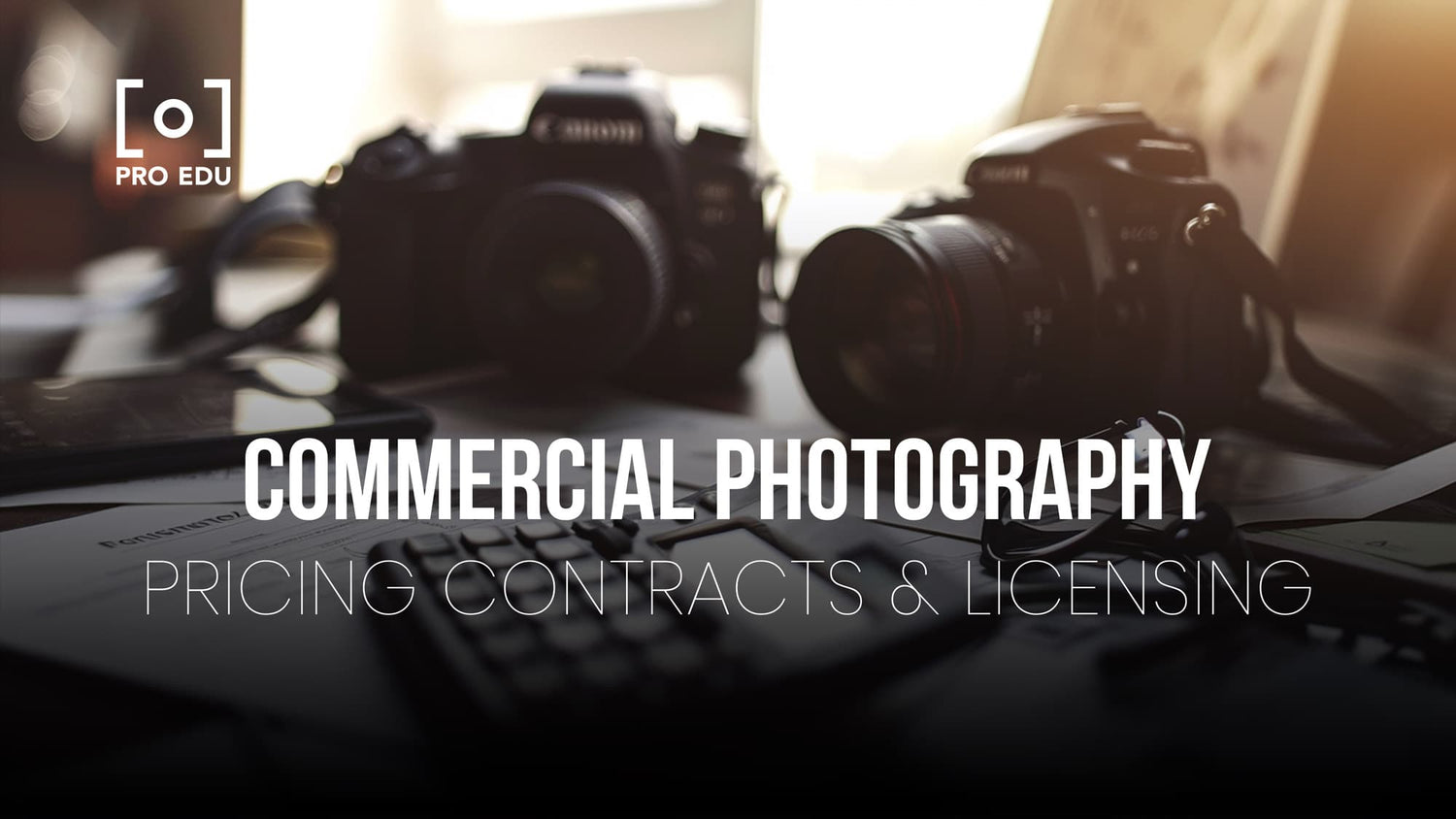Venturing into the realm of commercial photography involves more than just a keen eye for composition and the ability to capture stunning images. It's crucial to grasp the nuances of the business side, which can often be as complex as the creative process itself.
As commercial photographers, we confront a tapestry of pricing models, contract negotiations, and licensing agreements. Understanding how to navigate these elements is key to establishing a sustainable and profitable enterprise.
Accurately setting prices for our services sets the foundation for our business's financial health. It's about striking a balance that reflects the value of our work, our expertise, and the market demand.
In parallel, mastering the art of contract negotiation ensures we protect our interests and clearly outline the terms of our service offerings. Furthermore, managing licenses plays a pivotal role, as it dictates how our images are used by clients and can greatly affect our revenue.
Key Takeaways
- Understanding the business aspects of commercial photography is essential for success.
- Effective pricing and contract negotiation are fundamental to a photographer's financial stability.
- Properly managing image licenses can significantly impact a photographer's earnings.
Understanding Commercial Photography
In commercial photography, we must be precise in defining our services and understanding their worth. Let’s explore how to identify the range and set the value for these specialized photography skills.
Defining The Scope
The scope of commercial photography involves creating images specifically for business purposes. This can range from product advertisements to business headshots. Our focus here is to establish clear expectations and deliverables which, in turn, ensure the smooth execution of projects.
A thorough understanding helps us identify our niche within commercial photography, allowing us to specialize and cater to distinct market segments. For example, the Association of Photographers provides resources and standards that can guide us in specifying the parameters of our photography services.
Recognizing Market Value
When it comes to recognizing market value, it's critical that we conduct diligent research to discern what our work is worth within the commercial photography market. Factors that determine the value include the quality of work, the complexity of the shoot, and the usage rights of the images.
We should leverage various tools and resources, such as the Erik Almas course on composite photography, to stay informed about current rates and ensure that our pricing reflects our expertise and the demands of the market. It is our responsibility to communicate our value to clients and uphold the standards of the market.
Setting Your Pricing
In the world of commercial photography, effectively setting our pricing is crucial for our business's success. That means we need to develop a robust pricing strategy, establish a clear day rate, and accurately calculate additional fees.
Establishing a Pricing Strategy
Our pricing strategy is the foundation of financial success in commercial photography. To ensure profitability, we must consider our experience, market demand, and the unique value we offer. We also need to be adaptable and revise our strategy as we grow. It's essential to research the commercial photography pricing landscape to set a competitive yet fair price that reflects the quality of our work.
Determining Your Day Rate
Our day rate is a reflection of not just our time, but also our expertise, operational costs, and the quality of our equipment. We should calculate our day rate by accounting for these factors and ensuring it aligns with our financial goals. Here's a structure we can use to determine our day rate:
- Operational Costs: Consider fixed and variable costs.
- Experience: More experience often justifies higher rates.
- Equipment: Higher quality gear usually commands higher fees.
Calculating Additional Fees
Beyond our day rate, we must account for additional fees that may apply to a project. These could include post-production time, assistants, travel expenses, and rental gear. Each fee should be itemized and communicated transparently to the client. When it comes to licensing, we must charge according to the usage scope—more extensive use warrants higher fees. A resource for understanding how to navigate these charges is The Complete Guide to Pricing Commercial Photography.
Negotiating Contracts
When we navigate the intricacies of commercial photography contracts, our focus is on securing terms that honor our creative work and firm standing on pricing, licensing, and permitted use. Let’s ensure that we’re equipped with the knowledge of each clause, skilled negotiation tactics, and a solid grasp of rights and licensing.
Key Elements of a Photography Contract
Contracts are the backbone of professional agreements, serving as a legal document that protects both parties. To ensure our interests are safeguarded, we must include several crucial components:
- Scope of Work: Clearly define the project's boundaries and expectations.
- Payment Terms: Specify rates, licensing fees, and payment schedules.
- Cancellation Policy: Outline the terms if the client cancels or we cannot fulfill the contract.
- Deliverables: Enumerate the final products and formats we will provide.
- Copyright and Usage Rights: Clarify the extent of image use granted to the client.
By detailing these areas, we minimize ambiguities and set the stage for a transparent relationship with our clients.
Negotiation Techniques
Negotiation is pivotal in establishing a contract that’s fair and beneficial. Here are some strategies we employ:
- Preparation: Research industry standards and our client’s budget to establish realistic expectations.
- Assertiveness: Confidently communicate our value and why our pricing reflects the quality of our work.
- Flexibility: Consider alternative solutions or compromises, such as adjusting deliverables, to meet the client's needs while still protecting our interests.
These techniques place us in a favorable position to reach an amicable agreement.
Handling Rights and Licensing
Our photographs are our intellectual property, and licensing regulates how our clients can use them. We address the following in our contracts:
- Permitted Use: Specify how the images can be used, including the media, duration, and geography.
- Licensing Fee: Determine fees based on the usage scope; more extensive use commands a higher fee.
- Exclusivity: Decide whether to grant exclusive rights to the client, which may also affect the pricing.
By clearly articulating these factors, we maintain control over our work's use and ensure that we receive appropriate compensation for different licensing scenarios.
Managing Licenses
In commercial photography, effective license management is crucial. We'll guide you through understanding usage rights and setting up flexible licensing options to meet client needs and protect your work.
Understanding Usage Rights and Fees
Commercial photography licensing is centered around usage rights—the specific ways in which an image can be used by a client. These rights are often defined by several parameters, such as:
- Duration: How long the image can be used.
- Location: Geographic limits on where the image can be displayed.
- Distribution: The media through which the image can be shared.
- Exclusivity: Whether the rights granted are exclusive to the client or non-exclusive.
Usage fees are directly tied to these rights and can vary widely. It's essential we communicate clearly with clients about their needs and how these translate into the licensing agreement. A robust understanding of these concepts is the foundation of effective commercial photography licensing and usage fees.
Creating Flexible Licensing Options
To stay competitive and client-friendly, we should aim to provide a range of licensing options. Flexibility is key to cater to varying budgets and project scopes. Remember to document these options in contracts meticulously to avoid misunderstandings. Here's how we might define licensing tiers:
-
Standard License:
- Duration: 1 year
- Location: Nationwide
- Distribution: Up to 3 channels
- Exclusivity: Non-exclusive
-
Extended License:
- Duration: 3 years
- Location: Global
- Distribution: Unlimited channels
- Exclusivity: Exclusive
By structuring our commercial photography usage fees according to these tiers, we align the value of our work with the breadth of usage rights granted.
Pre-Production Essentials
In commercial photography, pre-production sets the foundation for a successful shoot. It's where we meticulously plan every detail, ensuring we have the budget and resources to achieve the client’s vision.
Budgeting for Your Shoot
We begin by determining the expenses associated with the project. It’s essential to account for every aspect: from equipment rental to talent fees, including props, wardrobe, and hair and makeup services. We also consider the cost of assistants to support the production. To avoid unexpected costs:
- List all potential expenses.
- Assign a cost estimate to each item.
- Factor in a contingency for unforeseen costs.
Organizing Teams and Equipment
With a clear budget in place, our next step is to assemble our team and organize the equipment needed. We ensure that team roles are defined, and that every member knows their responsibilities. We secure all necessary equipment, arranging for rentals if our in-house gear isn't sufficient. Props and wardrobe require special attention, with choices often aligned closely with the brand’s aesthetic. For hair and makeup, professionals are selected who can deliver the desired look under the constraints of the shoot.
By proactively managing these pre-production elements, we lay the groundwork for effective execution of commercial photography projects.
Post-Production Workflow
After the shoot wraps up, we enter the critical phase of post-production. This is where we elevate our work from just images to polished, professional photography ready for delivery.
Editing and Retouching
In editing, we select the best images from the shoot based on our client's requirements and our creative judgment. Each selected image is then adjusted for color balance, exposure, and contrast to ensure a consistent look across the entire set of photographs. Retouching takes this a step further by addressing specific imperfections in the images, such as blemishes on products or skin, and can involve more complex adjustments like compositing different images.
Calculating Post-Production Time
To effectively invoice our clients, we meticulously document post-production time, often in half-hour increments. We factor in the time spent on each of the following tasks:
- Selecting and cataloging images
- Basic adjustments: cropping, color correction, exposure adjustments
- Advanced retouching: skin or product imperfections, background removal
Post-production time directly influences our pricing and must be realistically estimated before the project starts to ensure that our invoice reflects the work done.
Handling Business Operations
In managing our commercial photography business, we focus on concrete strategies for financial stability and brand growth. Attention to details in taxes, insurance, and client acquisition ensures our operations run smoothly and profitably.
Dealing with Taxes and Insurance
Taxes: We carefully track our earnings and expenses to create an accurate profit and loss estimate. By doing so, we ensure that our tax filings reflect the true financial health of our business. We set aside a percentage of each payment as an advance on our tax obligations, preventing unexpected liabilities at the end of the fiscal year.
- Itemize Deductions: We list all possible deductible expenses to reduce taxable income.
- Quarterly Payments: We pay estimated taxes quarterly to avoid underpayment penalties.
Insurance: We maintain comprehensive business insurance to protect our equipment and liability.
- Equipment Insurance: This covers damage or loss, allowing us to replace gear swiftly.
- Liability Insurance: It safeguards our business against claims from third parties.
Marketing and Client Acquisition
Our marketing plan is tailored to highlight our value proposition and to build our reputation in the commercial photography market. To acquire and retain clients, we develop and maintain:
Value Proposition: We articulate what sets us apart from competitors, focusing on our unique skill set and the quality of our work.
- Competitive Edge: Clearly defined service offerings that showcase our expertise.
Client Outreach: We leverage both digital and traditional marketing strategies to reach potential clients.
- Networking: Engaging with industry professionals and attending events.
- Online Presence: Keeping our portfolio updated and being active on social media.
By managing these business operations with expertise and foresight, we lay the groundwork for a successful and sustainable commercial photography enterprise.
Maximizing Profits and Scaling
In commercial photography, our ultimate target is to maximize profits while effectively scaling our business. This requires a strategic approach to expanding and identifying long-term growth opportunities.
Expanding Your Photography Business
To expand our photography business, we focus on three primary aspects: increasing our operational capacity, diversifying our services, and optimizing pricing structures.
Operational Capacity: Ensuring we have the right technology is essential. Investing in high-caliber equipment enhances our productivity and the quality of our output, leading to a higher production fee due to the value delivered.
- Equipment: Upgrade to state-of-the-art cameras and editing software.
- Staffing: Hire skilled professionals or work with reliable consultants.
- Studio Space: Consider the costs and benefits of owning versus paying rental fees.
Diversifying Services: Offering a broad spectrum of photography services allows us to attract a more significant share of the market.
- Specializations: Introduce new genres of commercial photography into our offerings.
- Package Deals: Create bundled services that provide value to clients and increase our profits.
Optimizing Pricing: Develop a nuanced pricing strategy that reflects the value we provide while remaining competitive.
- A balanced approach to production charges ensures we cover costs and generate profit.
- Consider usage fees carefully, adjusting for the breadth and duration of the usage.
Strategies for Long-Term Growth
Developing strategies for long-term growth is critical to our business's endurance. We must set clear goals and analyze our progress regularly.
Profit Analysis: We meticulously track our earnings and expenses to understand our financial health. This helps us make informed decisions about reinvesting profits for growth.
- Utilize profit and loss statements to identify trends and opportunities for cost savings.
Market Research: Staying ahead of the curve involves continuous market research to inform our strategic decisions.
- Examine industry trends and adjust our business model to meet the demands of the evolving marketplace.
Networking and Partnerships: Building strong professional relationships can lead to collaborative projects that expand our reach and increase our revenue.
- Engage with other creatives and businesses to create a referral network that benefits all involved parties.
By concentrating on these areas, we are equipped to drive our commercial photography business towards sustained profitability and scale effectively in the market.
Frequently Asked Questions
In our collective experience, we have identified several recurring inquiries about the business aspects of commercial photography that matter to professionals in our field, including specific pricing strategies, the structuring of packages, and understanding licensing fees.
How do you price commercial product photography?
Pricing commercial product photography involves assessing the project scope, including the number of products, unique shots needed, and image usage rights. It's essential to factor in pre-production work, post-processing time, and the value these images provide to the client's marketing efforts.
How do you structure photography pricing packages for clients?
We structure photography pricing packages by offering tiered options that cater to various client needs. Each package includes a defined number of hours, deliverables, and sometimes, additional services like retouching. Customization depending on the project scope gives clients flexibility and clear choices.
What factors should be considered when calculating day rates for commercial photographers?
When calculating day rates, we consider our level of expertise, operational costs, and the market rates. It's also critical to include the time spent on the shoot and related activities such as setup and breakdown. Travel expenses and equipment rental, if applicable, also play a part in the final rate.
What is the best method to calculate licensing fees for photography?
The best method to calculate licensing fees is by evaluating the duration and breadth of image use, including geographical reach, mediums, and exclusivity of the images. Using industry-standard tools and guidelines, such as fotoQuote software, helps in determining appropriate fees.
How can usage fees be determined for different types of photography licensing?
Determining usage fees for different types of photography licensing requires us to look at factors like the client's size, the impact and visibility of the images, and the length of time the images will be used. Combining these aspects with tools that offer pricing benchmarks ensures fair pricing.
What are standard practices for charging clients in commercial photography?
Standard practices for charging clients in commercial photography include defining clear terms upfront, establishing a base creative fee, and itemizing additional costs like assistants, travel, or rental gear. Transparently detailing the usage rights for the images in the contract is also standard to avoid future disputes.





























